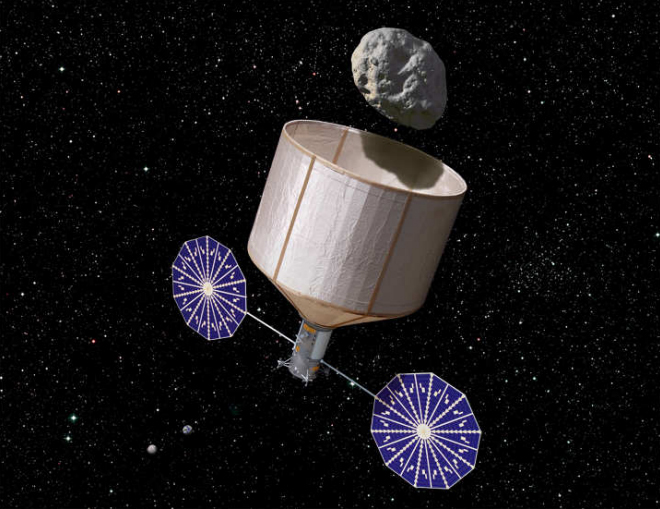NASA Eyes Wild Plan to Drag Asteroid Near the Moon

Capturing a near-Earth asteroid and dragging it into orbit around the moon could help humanity put boots on Mars someday, proponents of the idea say.
NASA is considering a $2.6 billion asteroid-retrieval mission that could deliver a space rock to high lunar orbit by 2025 or so, New Scientist reported last week. The plan could help jump-start manned exploration of deep space, carving out a path to the Red Planet and perhaps even more far-flung destinations, its developers maintain.
"Experience gained via human expeditions to the small returned NEA would transfer directly to follow-on international expeditions beyond the Earth-moon system: to other near-Earth asteroids, [the Mars moons] Phobos and Deimos, Mars and potentially someday to the main asteroid belt," the mission concept team, which is based at the Keck Institute for Space Studies in California, wrote in a feasibility study of the plan last year.
Space agency officials confirm that NASA is indeed looking at the Keck proposal as a way to help extend humanity's footprint out into the solar system. But the assessment is still in its early stages, with nothing decided yet.
"There are many options — and many routes — being discussed on our way to the Red Planet," Bob Jacobs, deputy associate administrator for the Office of Communications at NASA Headquarters in Washington, D.C., told SPACE.com via email. "NASA and the agency's Jet Propulsion Laboratory are giving the study further review to determine its feasibility." [NASA's Spacecraft for Asteroid Missions Revealed (Photos)]
Enabling manned exploration of deep space
In the Keck plan, an unmanned probe would snag a 25-foot-wide (7 meters) near-Earth asteroid, then haul it back to lunar orbit for future study and exploration.
Breaking space news, the latest updates on rocket launches, skywatching events and more!
Its developers see the mission as a way for humanity to get a toehold beyond low-Earth orbit, allowing our species to hone techniques and acquire skills that manned missions to more distant destinations will require.
For example, the robotic mission would help develop the precision flying techniques demanded by a manned mission to a near-Earth asteroid. Further, study of the captured space rock could teach researchers how to efficiently extract water from asteroids — a resource that could be an off-Earth source of radiation shielding and rocket fuel for journeying spacecraft.
"Extraction of propellants, bulk shielding and life support fluids from this first captured asteroid could jump-start an entire space-based industry," the Keck team writes. "Our space capabilities would finally have caught up with the speculative attractions of using space resources in situ."
Up-close examination of a captured asteroid would also yield insights into the economic value of space rock resources and shed light on the best ways to deflect potentially dangerous asteroids away from Earth.
Overall, the potential benefits of the mission are huge, the Keck team says.
"Placing a NEA in lunar orbit would provide a new capability for human exploration not seen since Apollo," the report reads. "Such an achievement has the potential to inspire a nation. It would be mankind’s first attempt at modifying the heavens to enable the permanent settlement of humans in space."
NASA's new spaceships
Human exploration of deep space beyond the moon is a NASA priority. In 2010, President Barack Obama directed the agency to get astronauts to a near-Earth asteroid by 2025, then on to the vicinity of the Red Planet by the mid-2030s.
To make all of this happen, NASA is developing a crew capsule called Orion and a huge rocket known as the Space Launch System. The Orion-SLS combo is slated to begin flying crews by 2021. The first unmanned Orion test flight is expected in 2017.
The space agency is also developing a new Space Exploration Vehicle for astronauts bound to explore a near-Earth asteroid. A prototype of the new vehicle, which could feature a rocket sled and "pogo stick" device for docking with an asteroid, coul dbe tested at the International Space Station in 2017, project officials have said.
Follow SPACE.com senior writer Mike Wall on Twitter @michaeldwall or SPACE.com @Spacedotcom. We're also on Facebook and Google+.

Michael Wall is a Senior Space Writer with Space.com and joined the team in 2010. He primarily covers exoplanets, spaceflight and military space, but has been known to dabble in the space art beat. His book about the search for alien life, "Out There," was published on Nov. 13, 2018. Before becoming a science writer, Michael worked as a herpetologist and wildlife biologist. He has a Ph.D. in evolutionary biology from the University of Sydney, Australia, a bachelor's degree from the University of Arizona, and a graduate certificate in science writing from the University of California, Santa Cruz. To find out what his latest project is, you can follow Michael on Twitter.

